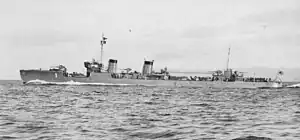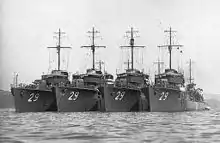Kamikaze-class destroyer (1922)
The Kamikaze-class destroyers (神風型駆逐艦, Kamikazegata kuchikukan) were a class of nine destroyers of the Imperial Japanese Navy.[1] Some authors consider the Nokaze, Kamikaze and Mutsuki classes to be extensions of the Minekaze-class destroyers, and the Kamikaze class is sometimes referred to as the "Kiyokaze class" to distinguish it from the earlier World War I-era destroyer class of the same name. Obsolete by the beginning of the Pacific War, the Kamikazes were relegated to mostly secondary roles. Most ultimately were lost to U.S. submarines.
 Kamikaze underway on 23 December 1922. | |
| Class overview | |
|---|---|
| Name | Kamikaze class |
| Builders | |
| Operators | |
| Preceded by | Wakatake class |
| Succeeded by | Mutsuki class |
| In commission | 1921–1947 |
| Planned | 27 |
| Completed | 9 |
| Cancelled | 18 |
| Active | 0 |
| Lost | 7 + 1 (postwar) |
| Retired | 1 |
| General characteristics | |
| Type | Destroyer |
| Displacement |
|
| Length |
|
| Beam | 9.1 m (30 ft) |
| Draught | 2.9 m (9.5 ft) |
| Propulsion |
|
| Speed |
|
| Range |
|
| Complement | 154 |
| Armament |
|
Background
The Kamikaze-class vessels were an extension and improvement to the ongoing Minekaze-class program as part of the Eight-eight fleet Plan. They were ordered under the 1921-1922 fiscal budget. As with the Wakatake class, they were originally given only numbers rather than names, but were assigned individual names on 1 August 1928.[2]
Construction of the last two planned Kamikaze vessels was cancelled in conformance with the Washington Naval Treaty. Oite, Hayate, Asanagi and Yūnagi were called the Kamikaze-class late production model (or occasionally Oite-class), as the powerplant and armaments were different.
Design

The Kamikaze-class ships were visually identical to the earlier Minekaze class, apart from slight detail changes in the bridge. The Kamikaze class was the first destroyer class in the Imperial Japanese Navy to be built with a bridge strengthened by steel plating. This gave the vessels a higher center of gravity, and to counteract this they were built with an increased displacement and a wider beam for better stability. Although they had slightly less speed >37.5 knots (69.5 km/h) they were considered satisfactory compared with the Minekaze class.[3]
Armament
The Kamikaze-class ships were essentially the same design as the Nokaze sub-class of the previous Minekaze-class destroyers. The three twin 21-inch (533 mm) torpedo tubes (one positioned in the well in front of the bridge and the other two located abaft the second stack) was unchanged; however, the launchers were now power-operated rather than manually-operated. The main battery was also unchanged, with four Type 3 120 mm 45 caliber naval guns in single open mounts, exposed to the weather except for a small shield. For anti-aircraft protection, the 6,5 mm machine guns mounted on each side of the bridge were replaced by two single 7.7mm machine guns. The final three vessels in the Kamikaze-class were also equipped with depth charges, with two Type 81 launchers deployed on the stern.
Following the start of the Pacific War, the Kamikaze-class vessels were modified for enhanced anti-aircraft capability at the expense of speed and surface warfare performance. One of both of the aft guns and the aft torpedo launcher were replaced by Type 96 25-mm anti-aircraft guns, which were added in increasing numbers, and eventually totaled between 13 and 20 guns per vessel in a combination of single and twin mounts. These modifications increased the displacement on some vessels to 1,523 tons, which reduced their maximum speed down to 35 knots.[4]
Operational history
The Kamikaze-class vessels all saw combat during the Pacific War, with Hayate having the distinction of being the first Japanese destroyer to be lost in combat during that conflict. She was sunk during the Battle of Wake Island in December 1941.[5] By 1944 four Kamikaze-class vessels had been sunk by American submarines and a fifth was lost in an air raid on Truk. In 1945 a sixth ship was sunk by submarine action. Only Kamikaze and Harukaze survived the war, but Harukaze was in such poor condition when surrendered at Sasebo that she was soon scrapped. Kamikaze continued on as a repatriation ship after it was surrendered at Singapore, but grounded off Cape Omaezaki in June 1946 and was written off.[6]
Class members
Note these vessels only carried numbers ("Dai") until 1 August 1928, when they were given meteorological names.
| Name | Kanji | Number | Builder | Laid down | Launched | Completed | Fate |
|---|---|---|---|---|---|---|---|
| Kamikaze | 神風 | Dai-1 | Mitsubishi-Nagasaki, Japan | 15 December 1921 | 25 September 1922 | 19 December 1922 | renamed Kamikaze on 1 August 1928; demilitarized repatriation ship 1 December 1945; grounded Omaezaki 7 June 1946; stricken 26 June 1946 |
| Asakaze | 朝風 | Dai-3 | Mitsubishi-Nagasaki, Japan | 16 February 1922 | 8 December 1922 | 16 June 1923 | renamed Asakaze on 1 August 1928; Torpedoed west of Luzon [16.06N, 119.44E] 23 August 1944; stricken 10 October 1944 |
| Harukaze | 春風 | Dai-5 | Maizuru Naval Arsenal, Japan | 16 May 1922 | 18 December 1922 | 31 May 1923 | renamed Harukaze on 1 August 1928; surrendered to USN 10 November 1945-11-10; scrapped 1947 |
| Matsukaze | 松風 | Dai-7 | Maizuru Naval Arsenal, Japan | 2 December 1922 | 30 October 1923 | 5 April 1924 | renamed Matsukaze on 1 August 1928; Torpedoed NW of Chichijima [26.59N, 143.13E] 9 June 1944; stricken 10 August 1944 |
| Hatakaze | 旗風 | Dai-9 | Maizuru Naval Arsenal, Japan | 3 July 1923 | 15 March 1924 | 30 August 1924 | renamed Hatakaze on 1 August 1928; sunk by air attack off Takao [22.37N, 120.15E] 15 January 1945; stricken 10 March 1945 |
| Oite | 追風 | Dai-11 | Uraga Dock Company, Japan | 16 March 1923 | 27 November 1924 | 30 October 1925 | renamed Oite on 1 August 1928; sunk by air attack at Truk [07.40N, 151.45E] 18 February 1944; stricken 11 March 1944 |
| Hayate | 疾風 | Dai-13 | Ishikawajima Shipyards, Japan | 11 November 1922 | 24 March 1925 | 21 November 1925 | renamed Hayate on 1 August 1928; combat loss in Battle of Wake Island [19.16N, 166.37E] 11 December 1941; stricken 10 January 1942 |
| Asanagi | 朝凪 | Dai-15 | Fujinagata Shipyards, Japan | 5 March 1923 | 21 April 1924 | 29 December 1925 | renamed Asanagi on 1 August 1928; torpedoed W of Ogasawara [28.20N, 138.57E] 22 May 1944; stricken 10 July 1944 |
| Yūnagi | 夕凪 | Dai-17 | Sasebo Naval Arsenal, Japan | 17 September 1923 | 23 April 1924 | 24 May 1925 | renamed Yūnagi on 1 August 1928; torpedoed NW of Luzon [18.46N, 120.46E] 25 August 1944; struck 10 October 1944 |
Naming history
The IJN originally planned that the Kamikaze-class ships should have names, but upon completion they were given numbers due to the projected large number of warships the IJN expected to build through the Eight-eight fleet plan. This proved to be extremely unpopular with the crews and was a constant source of confusion in communications. In August 1928, names were assigned, but not the original names that were planned.
| Final name (renamed 1 August 1928) |
Originally planned name | Name as completed | Renamed 24 April 1924 | |
|---|---|---|---|---|
| Name | Translation | |||
| Kamikaze | Divine Wind | Kiyokaze (清風), Pure Wind; or Soyokaze (微風), Breeze | Dai-1 Kuchikukan (第一駆逐艦), 1st Destroyer | Dai-1-Gō Kuchikukan (第一号駆逐艦), No.1 Destroyer |
| Asakaze | Morning Wind | Karukaze (軽風), Light Wind | Dai-3 Kuchikukan (第三駆逐艦), 3rd Destroyer | Dai-3-Gō Kuchikukan (第三号駆逐艦), No.3 Destroyer |
| Harukaze | Spring Wind | Makaze (真風), True Wind | Dai-5 Kuchikukan (第五駆逐艦), 5th Destroyer | Dai-5-Gō Kuchikukan (第五号駆逐艦), No.5 Destroyer |
| Matsukaze | Wind among the pine trees | Dai-7 Kuchikukan (第七駆逐艦), 7th Destroyer | Dai-7-Gō Kuchikukan (第七号駆逐艦), No.7 Destroyer | |
| Hatakaze | Wind causing waving of a flag | Dai-9 Kuchikukan (第九駆逐艦), 9th Destroyer | Dai-9-Gō Kuchikukan (第九号駆逐艦), No.9 Destroyer | |
| Oite | Fair Wind | Dai-11-Gō Kuchikukan (第十一号駆逐艦), No.11 Destroyer | — | |
| Hayate | Squall | Dai-13-Gō Kuchikukan (第十三号駆逐艦), No.13 Destroyer | ||
| Asanagi | Morning Calm | Dai-15-Gō Kuchikukan (第十五号駆逐艦), No.15 Destroyer | ||
| Yūnagi | Evening Calm | Dai-17-Gō Kuchikukan (第十七号駆逐艦), No.17 Destroyer | ||
| — | Ōkaze (大風), Great Wind | — | ||
| — | Tsumujikaze (旋風), Whirlwind | |||
Notes
- Jentsura, Warships of the Imperial Japanese Navy, 1869-1945
- Howarth, The Fighting Ships of the Rising Sun
- Globalsecurity.org, IJN Minekaze class destroyers
- Stille, Mark (2013). Imperial Japanese Navy Destroyers 1919–45. Vol. 1. Oxford, UK: Osprey Publishing. pp. 12–14. ISBN 978-1-84908-984-5.
- Brown. Warship Losses of World War II
- Watts & Gordon. Imperial Japanese Navy. p. 264.
References
Books
- Brown, David (1990). Warship Losses of World War Two. Naval Institute Press. ISBN 1-55750-914-X.
- Evans, David (1979). Kaigun: Strategy, Tactics, and Technology in the Imperial Japanese Navy, 1887-1941. US Naval Institute Press. ISBN 0-87021-192-7.
- Hara, Tameichi (1978). Japanese Destroyer Captain. Ballantyne Books, New York. ISBN 0-345-27894-1.
- Howarth, Stephen (1983). The Fighting Ships of the Rising Sun: The Drama of the Imperial Japanese Navy, 1895-1945. Atheneum. ISBN 0-689-11402-8.
- Jentsura, Hansgeorg (1976). Warships of the Imperial Japanese Navy, 1869-1945. US Naval Institute Press. ISBN 0-87021-893-X.
- Watts, Anthony J (1967). Japanese Warships of World War II. Doubleday. ISBN 978-0-3850-9189-3.
- Watts, Anthony; Gordon, Brian (1971). The Imperial Japanese Navy. Macdonald. ISBN 0356030458.
- Whitley, M J (2000). Destroyers of World War Two: An International Encyclopedia. London: Arms and Armour Press. ISBN 1-85409-521-8.
External links
- Globalsecurity.org. "IJN Kiyokaze class destroyers".
- Jones, Daniel H. (2003). "IJN Minekaze, Kamikaze and Mutsuki class Destroyers". Ship Modeler's Mailing List (SMML). Archived from the original on 2008-08-28.
- Japanese Destroyers: Tabular Movement Records (TROMs)
- Kamikaze Class, Japanese Destroyers